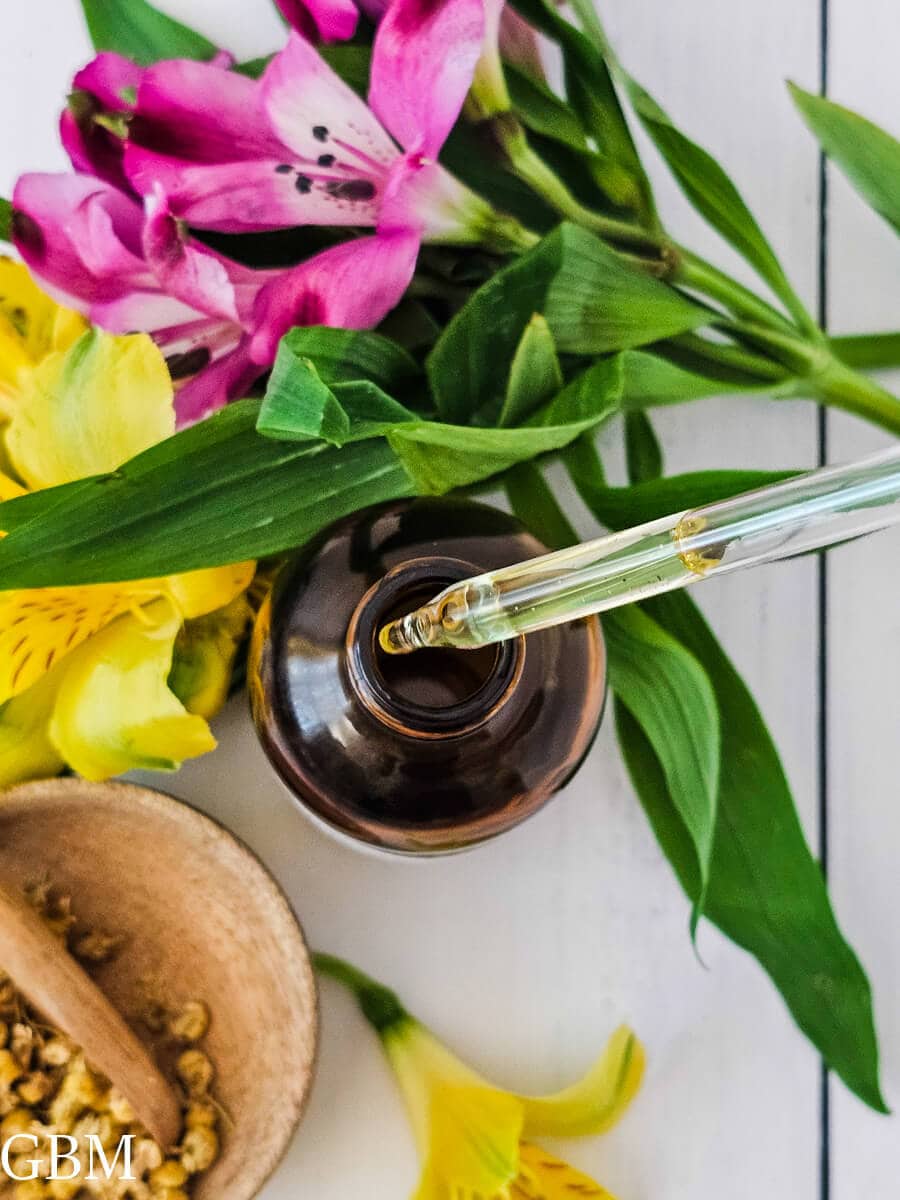How to Make Chamomile Oil
Learn how to make chamomile oil at home with simple, easily sourced ingredients. Discover the soothing benefits of chamomile infused oil for your skin and hair, plus easy tips for using your homemade chamomile oil in your DIY beauty, hair, and skincare products.

Tell me the truth, you read the headline of this and thought why would I put herbal tea on my face, skin or hair, didn’t you!
The humble little chamomile flower has been used for skincare for thousands of years. It’s even thought that Cleopatra used chamomile in her beauty routine! DIY Chamomile infused oil can be used to make salves, balms, lip balms, lotions, and even hair masks making it a beginner friendly, cheap and easy skincare project.
Here are just a few ways Chamomile can help your skin.
Anti-inflammatory properties: Chamomile contains compounds like bisabolol and chamazulene, which reduce inflammation, making it great for soothing irritated skin, redness, or conditions like eczema and rosacea.
Antioxidant-rich: Chamomile is packed with antioxidants, such as apigenin, which help protect the skin from free radicals and environmental stressors that contribute to aging and damage.
Calming and soothing: Chamomile is known for its calming effects both inside and outside your body. Not only will it soothe an upset stomach it can also, help to soothe sensitive or stressed skin, reducing puffiness, and calming conditions like acne.
Moisturizing and healing: Its ability to promote skin repair makes chamomile beneficial for healing minor cuts, sunburns, and irritation while keeping the skin moisturized.
Gentle for sensitive skin: Chamomile is mild and non-irritating, making it ideal for sensitive skin types or those prone to allergic reactions.

Who shouldn’t use chamomile?
As always, even something as mild as Chamomile isn’t always suitable for every person. Chamomile is part of the Asteraceae family. That’s the same plant family as ragweed, daisies, marigolds, and chrysanthemums. If you’re allergic to ragweed or these related plants you may also be sensitive to chamomile.
Always do a skin patch test first before adding a new herb to your skincare. With chamomile, this is easy. Just brew a strong cup of chamomile tea and dab a bit on your inner arm or behind your ear and wait 24 hours. If you notice any irritation, wash it off immediately!

Here’s what you’ll need to make Chamomile infused oil:
Dried Chamomile Flowers: You’ll need ½ cup high quality dried whole chamomile flowers. You can find these online, but also you can often find them in local grocery and health stores. Just look for organic whole flower chamomile loose leaf tea.
Olive Oil: I like using olive oil for this chamomile infused oil because it’s cheap, easily accessible and has a decent shelf life. It also has many soothing properties, which make it a great match for chamomile. However, jojoba oil, avocado oil, and almond oil all make great choices as well. It really comes down to what you’re planning to do or make with your chamomile oil.
Warm and cold oil infusions are two common methods for extracting the beneficial properties of herbs like chamomile into oils.

How to Make Chamomile Oil:
1. Warm Oil Infusion
This method uses gentle heat to speed up the extraction process.
- How it works: Herbs are submerged in a carrier oil (e.g., olive, jojoba, or almond oil) and gently heated over low temperatures for several hours.
- Methods: This can be done using a double boiler, slow cooker, or in the oven on low heat.
- Time: Typically takes 2–6 hours, depending on the method used.
- Pros:
- Faster extraction process.
- Ideal for herbs that require heat to release their full benefits (e.g., tougher, woody herbs).
- Cons:
- Risk of overheating the oil, which can degrade its quality or the beneficial properties of the herbs.
- Requires active monitoring to maintain a low and even temperature.

2. Cold Oil Infusion
This method relies on time rather than heat for extraction.
- How it works: Dried herbs are placed in a jar with a carrier oil and left to infuse over several weeks in a warm, sunny spot.
- Time: Typically takes 4–6 weeks.
- Pros:
- Gentle, slow process that preserves the delicate compounds in herbs
- Less risk of damaging the oil or herb properties from overheating.
- Easy to set up and requires minimal effort after preparation.
- Cons:
- Takes a long time (weeks) to achieve a full infusion.
- Might not extract the same concentration of beneficial compounds as warm infusions for certain herbs.
Choosing Between the Two Methods
It’s really up to you, your patience level and timeline on what method you choose. Neither is right or wrong.
How to use your Infused Chamomile Oil
Your Infused Oil can be used as:
- Facial Oil
- Body/ Massage Oil
- Healing Oil
- Hair Treatment
But you can also use it as an ingredient to make these homemade skincare recipes:

DIY Chamomile Infused Oil
Materials
- dried chamomile flowers
- olive oil (or other oil, such as jojoba or sweet almond)
Tools
- 1 slow cooker optional
Instructions
- Before you begin, decide on an infusion method.
- Gather the supplies needed. You'll need 1 part dried chamomile to 2 parts oil. For instance, 1/2 cup of chamomile flowers and 1 cup of olive oil.
- Add the chamomile flowers to a clean and sterilized glass jar. Pour the oil over the top of the flowers and seal the jar with a lid and ring. Gently shake the jar to make sure that all the flowers are submerged under the oil.
Cold Oil Infusion
- To do a cold oil infusion, simply place the jar in a warm sunny spot for the next 4 -6 weeks to allow the herbs to infuse into the oil.
- After 4-6 weeks, strain out the chamomile flowers using muslin cloth or a fine mesh strainer.
Warm Oil Infusion
- To do a warm oil infusion, fill a slow cooker to about half full with hot water. Place the tightly sealed jar in the slow cooker and turn the slow cooker to the warm setting. Put the lid on the slow cooker.
- Allow the herbs to infuse in the slow cooker for 8-10 hours. Then strain using muslin cloth or a fine mesh strainer.
- Store your infused oil in a clean sterilized jar. For the best results, store it in a cool dark place, such as a cabinet or closet.


